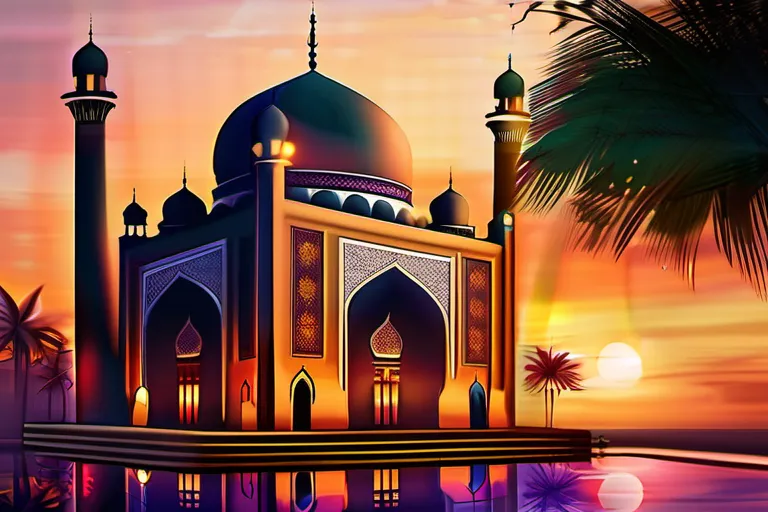Exploring the historical, cultural, and social impact of Islam as the world’s largest religion
Islam is the world’s fastest-growing major religion, with over 1.8 billion followers worldwide. In this article, we delve into the significance of Islam in today’s global context.
The Origins of Islam: A Brief History
The origins of Islam are like a thread that intertwines with the fabric of history, weaving together the lives of empires and individuals. The journey begins with Prophet Muhammad, whose life was marked by profound revelations that would transform not just his own community but also the entire world. How did he come to receive these divine messages? Was it a solitary experience or were there signs that pointed towards something greater?
The story of Islam starts in Mecca, where the Prophet Muhammad lived and preached. It was a time of intense persecution, as those who embraced his message faced ridicule and hardship. Yet, through perseverance and guidance from God, Muhammad continued to spread his teachings. How did he navigate the challenges that arose? Were there moments of despair, or did he find strength in the belief that his mission was divinely ordained?
The founding of Islam marked a new era in history. Its early spread was rapid and transformative, touching lives across the Arabian Peninsula and beyond. The Prophet Muhammad’s leadership was pivotal; his example of compassion, resilience, and commitment to justice set the foundation for a faith that has endured through centuries. Can you imagine the courage required to lead such a movement? How did his actions inspire others to follow?
The first Caliphs, who succeeded Muhammad, played crucial roles in establishing the principles of governance under Islam. They faced their own set of challenges and decisions that shaped the early Islamic caliphates. How did these leaders balance the expectations of maintaining justice with the complexities of ruling a diverse population? Their choices continue to be studied and debated even today.
The spread of Islam was not just geographical; it also brought about cultural exchanges, philosophical dialogues, and advancements in various fields such as science, medicine, and literature. How did Islamic scholars contribute to these areas? The legacy of these contributions echoes through time, reminding us of the profound impact that early Muslims had on the world.
The significance of the largest religion lies not only in its numbers but also in its rich tapestry of history, culture, and societal influence. By understanding Islam’s origins, we can gain deeper insights into a faith that has shaped countless lives and continues to inspire millions around the globe. What lessons can we learn from this journey? How does it resonate with your own beliefs or experiences?
Islam’s Core Beliefs and Practices
The core beliefs and practices of Islam form the bedrock upon which one billion Muslims worldwide stand, making it more than just a religion—it’s a way of life. Imagine a tree, its roots deeply entrenched in faith, branches reaching out to embrace humanity’s diverse cultures. What are the fundamental beliefs that keep this tree thriving?
In the heart of every Muslim lies the belief in one God, Allah, and the acceptance of Prophet Muhammad as His final messenger. This monotheistic faith is not just a declaration of belief; it’s a way to understand the interconnectedness of all creation under the divine plan. Muslims are constantly reminded that their actions have consequences, making each day a journey towards taqwa, or God-consciousness.
The five pillars of Islam serve as the framework for this daily practice. Reciting the declaration of faith (shahada) is like lighting a candle to illuminate one’s path in life. Offering prayers (salat) five times a day creates a rhythm that aligns personal time with the timeless will of God. Giving alms (zakat) is not just about charity; it’s about purifying one’s wealth and ensuring that resources are shared equitably.
Fasting during Ramadan is more than just abstaining from food and drink—it’s a spiritual cleansing, a reminder of self-restraint and compassion for those who face hunger. Lastly, making the pilgrimage to Mecca (hajj) is an act of submission and unity, where pilgrims from all corners of the globe meet under the same sky.
These practices aren’t just rituals; they are expressions of faith that bring Muslims together in a shared spiritual journey. Through these actions, Islam seeks not only to guide individuals but also to foster a community bound by common values and beliefs. As we explore further into the history and spread of this profound faith, remember: every step on the path to understanding Islam is a step towards appreciating its rich tapestry of beliefs and practices.
The Spread of Islam: A Global Perspective
Imagine if you will, a single seed planted in the arid sands of Arabia. From this seed sprouted not just a religion, but a global movement that would shape the course of human history for centuries to come. How did Islam, once confined to the Arabian Peninsula, become the world’s largest religion? The answer lies in its remarkable ability to adapt and thrive across diverse cultures and landscapes.
The spread of Islam can be traced through a series of interconnected waves, each one building upon the previous. From the bustling markets of Mecca to the grand palaces of the Umayyad Caliphate, the religion’s journey was not without its challenges. But it managed to overcome them with wisdom and strategic alliances.
One cannot discuss the expansion of Islam without mentioning the Rashidun Caliphs. Their reign laid down the foundational principles that guided the community’s growth. The ‘Pact of Umar’, for instance, is a testament to how early Islamic leaders respected and coexisted with non-Muslims in conquered lands. This approach was instrumental in minimizing resistance and fostering harmony.
The expansion continued under the subsequent caliphates, particularly during the Abbasid era. The shift from political control to cultural influence saw the rise of iconic cities like Baghdad, which became a beacon of learning and prosperity. Here, scholars translated works from various civilizations, leading to a flourishing of knowledge and innovation that has left an indelible mark on the world.
Islam’s spread was also facilitated by its ability to incorporate elements of local traditions and customs into its practices. This syncretic approach allowed the religion to not only survive but flourish in varied environments from Africa to Asia, each region adapting it uniquely yet maintaining core principles.
As we look at modern-day communities worldwide, one can see the enduring legacy of this global movement. The mosques dotting cities across continents are not just places of worship; they symbolize a shared heritage and a rich tapestry woven from diverse threads. In essence, the spread of Islam is a narrative of adaptation, resilience, and unity in diversity.
Islam’s Impact on Art and Architecture
How can something as intangible as art and architecture leave such a profound mark on our collective cultural landscape? When we delve into Islam’s impact on art and architecture, it’s like peeling back layers of history to uncover the intricate designs that have shaped global aesthetics.
Imagine standing in front of a grand mosque with its towering minarets, intricate calligraphy adorning the walls, and ornate geometric patterns decorating the floors. These architectural marvels are more than just buildings—they’re living testaments to the artistic and spiritual heritage of Islam. Each minaret reaches towards the heavens, symbolizing man’s desire to connect with the divine, while the calligraphy that covers the walls is like a whispered prayer transformed into visual poetry.
Islamic art, often seen as non-representational, focuses on abstract patterns and designs rather than human or animal figures. This approach isn’t just about avoiding idolatry; it’s a reflection of the belief in the infinite nature of God. The intricate patterns you see are like a dance of light and shadow, each line interwoven to create a sense of unity and harmony that echoes the beauty found in nature itself.
But how did these artistic expressions spread? They didn’t just travel with travelers; they were embedded in the very fabric of daily life. Islamic craftsmen, scholars, and traders carried their knowledge across continents, from Spain to India, leaving behind a rich tapestry of styles that blended local traditions with the universal language of Islam.
The influence of Islamic art and architecture isn’t limited to religious spaces either. Palaces, fortresses, and even private residences showcase the same attention to detail and symbolic depth. In a way, these structures serve as a reminder that beauty and spirituality are not confined to places of worship but can be found in every aspect of life.
By exploring the significance of Islamic art and architecture, we uncover a story of creativity and resilience, where each piece tells a part of the human experience. These works of art and buildings stand as enduring symbols of faith and culture, reminding us that beauty transcends borders and time itself.
Islam in Modern Times: Challenges and Opportunities
Islam, as the world’s largest religion, faces numerous challenges in modern times, but it also presents opportunities for dialogue and cooperation. How does one navigate these complexities? How can we ensure that Islam thrives while fostering understanding among different communities?
The global Muslim population is diverse, encompassing a wide range of cultures and societies. However, many Muslims find themselves grappling with issues such as social injustice, political oppression, and sectarian conflicts. These challenges are multifaceted and often interlinked. For instance, in countries where religious freedom is restricted, the oppression can lead to a sense of disenfranchisement among Muslims.
On the other hand, there are opportunities for interfaith dialogue that could help bridge gaps between different communities. In many places, Muslims have shown a willingness to engage with people of other faiths, promoting peace and understanding. For example, initiatives like interfaith dialogues and shared community projects can foster mutual respect and cooperation.
The question then arises: How do we harness these opportunities while addressing the challenges? One approach is through education. By educating Muslims about the values of tolerance and diversity within their own traditions, we can empower them to be advocates for peace in a world that often seems divided. Similarly, engaging non-Muslims in understanding the richness of Islamic teachings could break down stereotypes and foster a more inclusive society.
In conclusion, while the challenges facing Islam are significant, they also present opportunities for growth and harmony. By fostering dialogue, education, and mutual respect, we can work towards a future where Islam is not only respected but also celebrated as an integral part of the global community’s tapestry.
The Future of Islam: Trends and Predictions
The future of Islam is a dynamic tapestry, woven from threads of demographic shifts and technological advancements. As we look into the horizon, one cannot help but ponder: How will these trends shape the religion and its followers? Will the increasing urbanization in many Muslim-majority countries lead to a more secularized society, or will it strengthen the faith through community engagement?
The digital age presents both challenges and opportunities. On one hand, social media platforms can be powerful tools for spreading knowledge and fostering dialogue. But on the other hand, they also provide a breeding ground for misinformation and extremism. How can Muslims navigate this complex landscape? Should they embrace technology wholeheartedly or approach it with caution?
Demographic shifts are another critical factor. With younger generations increasingly forming the majority in many Muslim communities, what beliefs and practices will they uphold? Will they be more inclined towards traditional interpretations of Islam, or might they push for more progressive reforms that align with modern values and human rights? The answer to these questions lies in their hands, as they forge a path forward.
Technological advancements promise greater connectivity and access to information. However, this also means that voices from around the world will be heard more clearly than ever before. How will Muslims engage with these diverse perspectives? Will they find common ground or clash over differing interpretations of faith?
The future of Islam is not predetermined; it is a journey that we are all part of. As we stand on the threshold, the question looms large: What role will Islam play in shaping our global community? The answers to this lie within each one of us, as we choose how to embrace or adapt to these emerging trends.
Conclusion
 By understanding the historical and cultural roots of Islam, as well as its contemporary impact, we gain a deeper appreciation for its role in shaping our world.
By understanding the historical and cultural roots of Islam, as well as its contemporary impact, we gain a deeper appreciation for its role in shaping our world.











